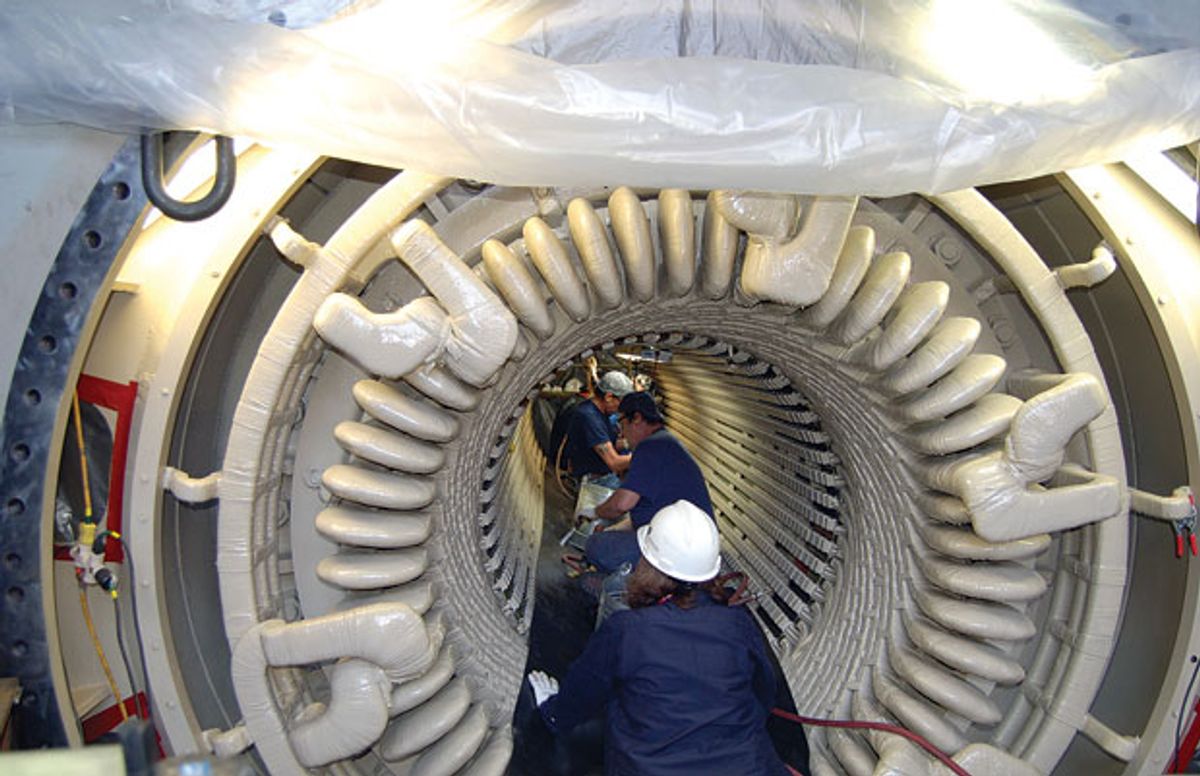Environmental regulations and competition from gas-fired turbines and renewable energy sources are shutting down dozens of older coal-fired power plants across North America and Europe. But some of these aging plants’ induction generators will go on spinning for years after their furnaces and turbines are scrapped. That’s because operators need new ways to stabilize grids deprived of big power plants, and huge, free-spinning generators synced to a grid’s AC frequency—synchronous condensers—are becoming an increasingly popular option.
The most recent such conversion is under way at the 62-year-old Eastlake coal-fired power plant near Cleveland. Here, Akron, Ohio–based utility FirstEnergy has repurposed three large generators and has two more conversions in process, due to start operating by June 2016. Several other conversions have recently been completed in California and Germany, and newly built synchronous condensers are now appearing on power grids, too.
Synchronous condensers are dynamic controllers of reactive power—AC whose current wave leads or lags the voltage wave and whose presence determines local grid voltage. Adding current to the spinning condenser’s coils produces reactive power—measured in volt-amperes reactive, or VARs—and boosts grid voltage. Reduce the current and the machine absorbs VARs, depressing voltage.
Extra reactive power is often required in areas that are losing their large power plants, because millions of VARs are needed locally to boost the voltage of power transmitted from distant plants. Eastlake’s synchronous converters were ordered after FirstEnergy announced plans to shutter 2,285 megawatts of coal-fired capacity—21 percent of the region’s power supply—starting in 2012.
Repurposing old power-plant generators is part of a larger comeback story for a technology that seemed doomed with the advent of solid-state controllers in the 1970s. Thyristor-based static VAR compensators (SVCs) quickly conquered the market for dynamic voltage support because they produced VARs more cheaply and efficiently than synchronous condensers.
Their predecessors started making a comeback a decade ago, however, thanks to faster control systems and a growing recognition that spinning machines offered some crucial advantages over electronics. Those pros stem from a spinning rotor’s mechanical and electromagnetic inertia, which make the machines more tolerant of grid disturbances.
Severe voltage drops, for example, hobble SVCs, whose reactive power output drops at double the rate of line voltage. In contrast, a synchronous condenser’s spinning rotor keeps on pumping out reactive power. It will also generate real power if needed, moderating the drop in AC frequency that would result, say, from shutting down a power plant.
And the condenser’s output can briefly handle several times its rated capacity for tens of seconds as its metal components heat up temporarily—behavior that is not possible for devices relying on comparatively fragile silicon switches. “Because they’re iron and copper, they have a lot of overload capability. You can’t overload silicon significantly,” says Nicholas Miller, a power systems expert with GE Energy Consulting, in Schenectady, N.Y.
New synchronous condensers remain 10 to 20 percent more costly per VAR of reactive power capacity than an SVC, say utility planners. But converting a well-maintained generator can be quicker and cheaper.
Speed was a critical factor in the California Independent System Operator’s decision to order a condenser conversion, though in a gas-fired plant instead of a coal plant, following the shuttering in 2012 of the San Onofre nuclear power plant. Without the 2,200-MW plant, located between Los Angeles and San Diego, voltage control weakened all across Southern California. “The potential for rolling blackouts in the L.A. basin was seen as a very high risk,” says Chris Davidson, an electrical solutions business-development director for Siemens, which did the conversion.
Seeing what the converted condensers could do, meanwhile, inspired San Diego Gas & Electric Co. to start one of the largest deployments of new synchronous condensers. The utility expected to start spinning its first two condensers last month and plans to install five more in 2017.
And many more condensers are likely in the United States because of accelerating coal plant shutdowns. The U.S. Energy Information Agency projects that existing pollution regulations and new carbon limits could shutter about 30 percent of U.S. coal power capacity by 2020. That will leave many generators available for conversion to stabilize future power grids carrying much higher levels of wind and solar power.
Studies directed by GE’s Miller for the U.S. National Renewable Energy Lab show that converted condensers could serve as a bulwark against blackouts on future grids. Though the electronic inverters built into renewable power plants can help manage grid stability far more than is appreciated today, they lack the inertia that can help get a grid through a major fault.
Miller notes, however, that synchronous condensers aren’t the only potential solution. For example, gas-fired power plants can now be equipped with clutches that decouple their turbines from their generators, allowing the generator to temporarily serve as a condenser.
Another wild card to watch, says Miller, is wind power. “You can suck some of the energy out of that rotating mass temporarily and give it to the grid,” says Miller.
May the smartest spinners win.
This article originally appeared in print as “Old Coal’s New Role.”
